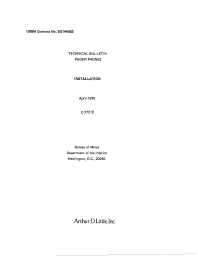Mining Publication: Technical Bulletin Pager Phones: Installation
Original creation date: April 1975
The pager phones used in many underground coal mines are battery operated, party-line telephones with provisions for loudspeaker paging. The system is two-wire, non-polarized, and is operated by self-contained batteries. Many of the individual units are certified as permissible. Requirements for installation are specified in state and federal regulations, such as in the Code of Federal Regulations, Title 30, Mineral Resources, Part 75. The major federal regulations that affect communication in coal mines are noted below, with a brief description of the subject matter in each of the relevant paragraphs. Refer to the cited paragraphs of Title 30 for explicit details of these regulations. (This brief description is for reference purposes only.) 1. Minimum Requirements: (paragraphs 75.1600, 75.17 13-2, and 75.1003-1) Approved telephone or two-way communication will be provided between the surface and each main shaft landing and each working section; to the nearest medical assistance; and shall be protected from contact with trolley wires or trolley feeder wires. 2. Installation Requirements (paragraphs 75.5 16-2, 75.52 1, and 77.508-1 ) Communication wires will be supported on insulated hangers, attached to messenger cables, or buried, to protect against mechanical damage; installed opposite trolley wires; and insulated near power conductors... each cable will have lightning arresters within 100 feet of going below ground... and arresters will be provided wherever telephone wires enter a building. 3. Wire and Cable Requirements (paragraphs 75.5 16-2, 75.5 17, and 75.52 1) Communication cable means two or more insulated conductors, covered by an additional abrasion-resistant covering; power wires and cables shall be adequately insulated and fully protected; and lightning arresters shall be connected to low-resistance grounds, more than 25 feet from neutral grounds. This technical bulletin is based on: the requirements of Title 30; installation practice recommended by equipment manufacturers; the experience of repair personnel; industrial telephone communication experience; and Rural Electrification Authority (REA) practices. A description of the many telephones available is included in the bulletin Introduction; the types of wire and cable to be used in these installations are described in the bulletin Cable Selection; and proper care and procedures for connecting and splicing the interconnecting cable are described in the bulletin Splices and Connections. The following text includes excerpts from those bulletins, to supplement the installation recommendations. Detailed information on each subject should be obtained from the individual technical bulletins.
Authors: Arthur D. Little, Inc.
Contract/MOA Report - April 1975
NIOSHTIC2 Number: 20031848
U.S. Department of the Interior, Bureau of Mines, Contract No. S0144082, 1975 Apr; :1-13
See Also
- Development of a Visual Display and Control System
- Medium-Frequency Propagation in Coal Mines
- Research and Development Contract for Coal Mine Communication System: Volume 1 - Summary and Results of System Study
- Research and Development Contract for Coal Mine Communication System: Volume 2 - Mine Visits
- Research and Development Contract for Coal Mine Communication System: Volume 3 - Theoretical Data Base
- Technical Bulletin Pager Phones: Circuit Protection
- Theory on the Propagation of UHF Radio Waves in Coal Mine Tunnels
- U.S. Bureau of Mines New Developments in Mine Communications
- Ultra-Low Frequency Through-the-Earth Communication Technology
- Underground Coal Mining Disasters and Fatalities: United States, 1900-2006
- Page last reviewed: 9/21/2012
- Page last updated: 9/21/2012
- Content source: National Institute for Occupational Safety and Health, Mining Program


 ShareCompartir
ShareCompartir
